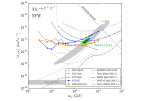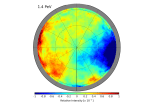The Precision IceCube Next Generation Upgrade (PINGU) is the proposed infill extension in a region at the center of the IceCube Neutrino Observatory that will lower the energy threshold to a few GeV, dramatically increasing both the number of GeV-scale neutrinos detected by IceCube and, more importantly, the precision with which they are measured. […]
Research
Searching for dark matter using IceCube cascades
The IceCube Collaboration presents a new search for dark matter annihilation from the galactic center and halo using cascade events, i.e., particle showers created by the interaction of electron and tau neutrinos and Z-boson mediated muon neutrinos. Scientists searched for interactions starting in the DeepCore subarray between May 2011 and May 2012 and found no neutrino excess with respect to the background-only hypothesis, which allowed them to derive upper limits on dark matter candidates with masses between 30 GeV and 10 TeV. These results have been submitted today to the European Physical Journal C. […]
IC86-2016, or a new physics run for IceCube
“On behalf of the operations group, I’m happy to report that as of run 127950 on 2016-05-20, 20:38:47 UTC, we have started the IC86-2016 physics run.” With these words, every IceCuber learned that we were entering a new year of data for IceCube. […]
A first search for sterile neutrinos in IceCube
The IceCube Collaboration has performed two independent searches for light sterile neutrinos, both with one year of data, searching for sterile neutrinos in the energy range between approximately 320 GeV and 20 TeV. IceCube has not found any anomalous disappearance of muon neutrinos and has placed new exclusion limits on the parameter space of the 3+1 model, a scenario with only one sterile neutrino. These results have been submitted today to Physical Review Letters. […]
Improving searches for point sources below 100 TeV
Today, the IceCube Collaboration presents a new technique to lower the energy threshold for neutrino detection while keeping a pointing resolution to within less than a degree. IceCube researchers have used this technique in a joint search with data from a previous analysis using throughgoing muon neutrinos. No point source has been found, but sensitivity for searches below 100 TeV has been improved by a factor of ten. […]
A closer look at the cosmic ray anisotropy with IceCube
The IceCube Collaboration is updating the cosmic ray anisotropy maps using 318 billion cosmic-ray-induced muon events detected in IceCube between May 2009 and May 2015. The larger data sample allowed discerning new regions in the anisotropy maps, which shed some light on the physical processes that stir up the variations in the arrival direction of cosmic rays. These results have been recently submitted to The Astrophysical Journal. […]
A search for neutrinos in coincidence with the first gravitational wave event
The detection of the first gravitational wave (GW) event by LIGO represents one of the greatest scientific breakthroughs of recent years. After receiving the gravitational wave alert in September 2015 from the Advanced LIGO detector, the IceCube and ANTARES neutrino telescopes analyzed the data they had recorded at the same time in order to search for neutrinos that might have been emitted from the same event. Neither search identified any neutrinos that could be associated with the burst. These results set the first limits on neutrino emission from a GW transient event. […]
Further limits on the GRB contribution to astrophysical neutrinos and ultra-high-energy cosmic rays
Today, the IceCube Collaboration announces a new search for neutrino emission from GRBs with a first-ever search that covers all flavors and the full sky. Five events were found to have a low-significance correlation with five GRBs. Consequently, the analysis places tight constraints on current models of neutrino and ultra-high-energy cosmic ray (UHECR) production in GRBs. These results have just been submitted to The Astrophysical Journal. […]
Improving dark matter searches with neutrino telescopes
In 2013, the IceCube Collaboration published the world’s best limits on the spin-dependent cross section for weakly interacting dark matter particles. They were derived from the non-observation of annihilation into neutrinos of dark matter gravitationally trapped by the Sun.
Now, the collaboration presents a new likelihood formalism that allows easy integration of any neutrino telescope data into analyses of dark matter theories. […]
A search for cosmic-ray sources with IceCube, the Pierre Auger Observatory, and the Telescope Array
In a new study by the IceCube, Pierre Auger, and Telescope Array Collaborations, scientists have looked for correlations between the highest energy neutrino candidates in IceCube and the highest energy cosmic rays in these two cosmic-ray observatories. The results, submitted today to the Journal of Cosmology and Astroparticle Physics, have not found any correlation at discovery level. However, potentially interesting results have been found and will continue to be studied in future joint analyses. […]









